3d Operations Group
| 3d Operations Group | |
|---|---|
 90th Fighter Squadron Lockheed Martin F-22A Block 30 Raptor 05-4105 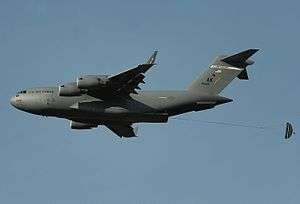 517th Airlift Squadron Boeing C-17A Lot XI Globemaster III 99-0168  62nd Airborne Air Control Squadron E-3B | |
| Active | 1919–1957; 1991–present |
| Country |
|
| Branch |
|
| Type | Operations Group |
| Engagements |
|
| Decorations |
|
| Insignia | |
| 3d Operations Group emblem |
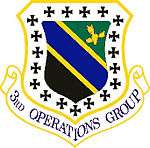 |
The 3d Operations Group (3 OG) is the operational flying component of the United States Air Force 3d Wing. It is stationed at Elmendorf Air Force Base, Alaska, and is assigned to the Pacific Air Forces (PACAF) Eleventh Air Force.
The 3 OG is a composite organization that provides air superiority and defense for Alaska flying F-22A Raptor Stealth aircraft. In addition, the group supports Pacific Air Forces in the Pacific Command area of responsibility flying C-17 Globemaster III transports and E-3B sentry Airborne early warning and control (AWACS) aircraft.
The group is a direct successor organization of the 3d Attack Group, one of the 15 original combat air groups formed by the Army before World War II. It is the oldest active group in the USAF, and the first created after the establishment of the U.S. Air Service. Based in Texas after World War I, the group patrolled the Mexican Border from Brownsville, Texas, to Nogales, Arizona. The group pioneered dive bombing, skip-bombing, and parafrag attacks in the 1920s—the earliest forms of precision guided attack from aircraft—and put this work to good use in World War II.
The World War II 3d Bombardment Group moved to Australia early in 1942 and served primarily in the Southwest Pacific Theater as a light bombardment group assigned to Fifth Air Force. The group participated in numerous campaigns during the war, engaging in combat over Japan; Netherlands East Indies; New Guinea; Bismarck Archipelago; Western Pacific; Leyte; Luzon and the Southern Philippines. On 2 November 1943, the group encountered heavy opposition from Japanese forces at Simpson Harbor, New Britain. In that attack Major Raymond H. Wilkins, commander of the 8th Bombardment Squadron, sank two ships before he was shot down as he deliberately drew the fire of a destroyer so that other planes of his squadron could withdraw safely-an action for which Maj Wilkins was posthumously awarded the Medal of Honor.
The 3d again served in combat during the Korean War, using B-26 Invader light bombers. Captain John S. Walmsley, Jr. was posthumously awarded the Medal of Honor for his actions a night mission. Capt Walmsley discovered and attacked an enemy supply train, and after exhausting his ammunition he flew at low altitude to direct other aircraft to the same objective; the train was destroyed but Walmsley’s plane crashed in the target area.
Notable alumni include General Hoyt S. Vandenberg, General Jimmy Doolittle, General Lewis Brereton, General Richard Ellis, General John Henebry, Major Paul I. "Pappy" Gunn, and General Nathan Twining.
Overview
The 3 OG Mobilizes, deploys, and employs three different squadrons of F-15C/D, F-22, C-17, 2 E-3Bs, and C-12Fs aircraft worldwide to accomplish air superiority, air battle management, air interdiction, counter narcotics, airlift, and air daily air sovereignty missions to achieve dominant maneuver, precision engagement, and information superiority in support of CJCS, PACOM, CENTCOM, SOUTHCOM, and NORAD operations.
Assigned squadrons to the group are:
- 3d Operations Support Squadron
- 90th Fighter Squadron
- 517th Airlift Squadron
- 525th Fighter Squadron
- 962d Airborne Air Control Squadron
Heraldry
Shield: Party per bend vert and sable in chief a cactus (prickly pear) or, a bend azure fimbriated of the third, all within a bordure argent charged with nineteen crosses patee of the second.
Crest: On a wreath of the colors an arm couped near the shoulder paleways with hand clenched proper between two wings conjoined in lure argent.
Motto: Non Solum Armis -Not by Arms Alone. (Approved 17 January 1922. This insigne was modified 22 December 1952.)
History
- For additional lineage and history, see 3d Wing
- See United States Army Air Service Mexican Border Patrol
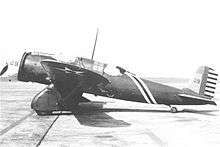

The 3d Group and its successor units have served the United States on a continuing basis since the group's activation as the Army Surveillance Group on 1 July 1919.[1] In August 1919 the Air Service organized its first seven groups and it became the 1st Surveillance Group. Initially the group used Airco DH-4B's to patrol the border from Brownsville, Texas, to Nogales, Arizona, as revolution and disorder had broken out in Mexico, resulting in border violations and the killing of American citizens.
In a functional redesignation of Air Service groups, the unit was redesignated as the 3d Attack Group in 1921. It participated in maneuvers, tested new equipment, experimented with tactics, flew in aerial reviews, patrolled the United States–Mexico border (1929), and carried Airmail (1934) flying a wide variety of biplanes (DH-4, XB-1A, GA-1, A-3).
On 1 March 1935, the Army Air Corps formed the first centralized control of its combat striking units within the United States under the General Headquarter Air Force. The 3d Attack Group moved to Barksdale Field, Louisiana, as part of the 3d Wing commanded by Col. Gerald Brant, together with the 20th Pursuit Group. Aircraft assigned to the 3d Attack Group were the Curtiss A-12 Shrike in 1935 and the Northrup A-17/A-17A Nomad in 1937.
The commander of the 3d Attack Group, Lt. Col. Horace Meek Hickam, was killed on 5 November 1934, when the A-12 he was piloting (33–250) crashed while landing at Fort Crockett, Texas. Hickam Field was named in his honor. Some A-12s were still at Hickam Field on 7 December 1941, when the Japanese attacked, however, none of the aircraft saw any combat. The A-12 was withdrawn from service soon after.
The A-17s were was fairly fast and had a fairly heavy forward-firing armament for its time, and during 1938–39 war games it was deemed to be the most effective ground attack aircraft yet devised. However the career of the A-17 with the Army was quite brief. After only three years of service with the Army, the A-17As were declared surplus. In 1940, the unit was redesignated as the 3d Bombardment Group (Light), being reequipped with the Boeing B-18 Bolo and B-12 bombers and reassigned to Savannah Airfield, Georgia.
World War II
![]() Media related to United States Army Air Forces 3rd Bombardment Group at Wikimedia Commons
Media related to United States Army Air Forces 3rd Bombardment Group at Wikimedia Commons
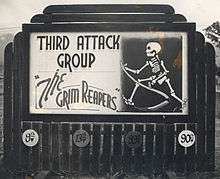
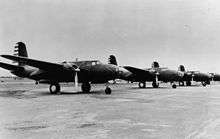
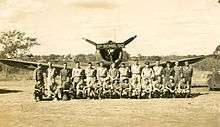

The 3d Group served in combat in the Pacific Theater of Operations from 1 April 1942 until V-J Day. It was transferred to Australia early in 1942 as part of the United States Army Forces in Australia under Gen. George H. Brett and later the Fifth Air Force under Gen. George C. Kenney.
On 2 April 1942, Lt. Col. John H. Davies was appointed to command the group, which had been shipped overseas under command of a first lieutenant and without aircraft. Davies had been in command of the 27th Bomb Group in the Philippines when war broke out, then had become stranded in Australia with 22 of his pilots after attempting to ferry the A-24 dive bombers being shipped to the 27th. These provided a leadership cadre and air crews for the 3d Group. Their first aircraft acquired were 15 B-25 Mitchells, newly assembled but without crews, which had been shipped to Australia for the Royal Netherlands East Indies Army Air Force (ML-KNIL). With these the group conducted the first bombing mission ever flown by B-25s, sending six bombers to Gasmata, New Britain, on 6 April. Ten staged through Darwin to Mindanao on 10 April, flying two days of sorties against Cebu City and Davao on 12 and 13 April, before returning with passengers being evacuated from the Philippines.[2]
While officially designated the 3d Bombardment Group (Light), the group unofficially styled itself with its historic name, the "3d Attack Group," after being equipped with low-altitude strafing bombers. Field-modified with .50 caliber machine guns taken from wrecked fighters, these strafing bombers were the brainchild of a former naval aviator serving in the USAAF, Paul "Pappy" Gunn,The 13th and 90th Squadrons were equipped with its "Dutch" B-25s field modified into the B-25C-1 strafer configuration. The 89th Squadron flew the Douglas A-20A Havoc attack bomber while the 8th Squadron used the Douglas A-24 dive bomber until July 29, 1942, but also used the B-25 and A-20.
The group had its headquarters in Australia until January 1943, but its squadrons operated from forward locations in New Guinea, bombing and strafing enemy airfields, supply lines, installations, and shipping as the Allies halted the Japanese drive toward Port Moresby and drove the enemy back from Buna to Lae. At the end of that campaign, group headquarters moved to New Guinea.
For the next year and a half the group continued to serve in the Southwest Pacific, where it played an important role in the offensives in which the Allies pushed along the northern coast of New Guinea, taking Salamaua, Lae, Hollandia, Wakde, Biak, and Noemfoor. In March 1943 it took part in the Battle of the Bismarck Sea, which ended Japanese attempts to send convoys to Lae. In August 1943, when Fifth Air Force struck airfields at Wewak to neutralize Japanese airpower that threatened the advance of Allied forces in New Guinea, the group made an attack in the face of intense antiaircraft fire on 17 August, destroyed or damaged many enemy planes, and won a Distinguished Unit Citation for the mission.
In the fall of 1943 the group struck Japanese naval and air power at Rabaul to support the assaults on Bougainville and New Britain. In an attack on shipping at Simpson Harbor, New Britain, on 2 November 1943, the 3d Group encountered heavy opposition from enemy fighters and from antiaircraft batteries on the ships. In that attack Major Raymond H. Wilkins, commander of the 8th Squadron, sank two ships before he was shot down as he deliberately drew the fire of a destroyer so that other planes of his squadron could withdraw safely – an action for which Maj Wilkins was posthumously awarded the Medal of Honor.
The group moved to the Philippines late in 1944. Equipped with A-20's, it bombed and strafed airfields; supported ground forces on Mindoro, Luzon, and Mindanao; attacked industries and railways on Formosa; and struck shipping along the China coast.
The group moved to Okinawa early in August 1945 and flew some missions to Japan before the war ended. Moved to Japan in September 1945 and, as part of U.S. Far East Air Forces, became part of the army of occupation.
Korean War

Flying Douglas A-26 Invaders (after 1948, the B-26) the 3d Wing participated from the first bombing sortie to the very last during the Korean War. The first Americans to lose their lives during the Korean War, 1Lt. Remer L. Harding and SSgt. William Goodwin, were assigned to the 13th Bomb Squadron, 3d Bombardment Group when they lost their lives 28 June 1950 returning from a sortie on the Korean Peninsula. Captain John S. Walmsley, Jr. was posthumously awarded the Medal of Honor for his actions on 14 September 1951: flying a night mission in a B-26, Capt Walmsley discovered and attacked an enemy supply train, and after exhausting his ammunition he flew at low altitude to direct other aircraft to the same objective; the train was destroyed but Walmsley's plane crashed in the target area.
In recognition of the wing's distinguished service, the 3d Bombardment Wing's was granted the privilege of conducting the last bombing mission over North Korea minutes before implementation of the ceasefire of 27 July 1953.
Cold War
With the war over in Korea, wing returned to the routine of peacetime duty in the Cold War environment. It remained at Kunsan Air Base until October 1954, when it moved to Johnson AB, Japan. Beginning in January 1956, the 3d Bombardment Group converted from the B-26 to the Martin B-57B Canberra Night Intruder. By August 1956, the Group had become a paper unit, with only one officer and one airman assigned for record purposes. Its squadrons were attached to the 3d Bombardment Wing, which had assumed its duties. On 25 October 1957, those squadrons were transferred to the wing and the group inactivated.
Post Cold War era

In 1991, activated in Alaska after 34 years on the inactive list, and expanded the air defense mission of the 3d Wing, to include deep interdiction and air-to-air capabilities with the F-15E aircraft. Added an airlift capability in April 1992, using C-130 and C-12 aircraft, providing worldwide combat airdrop, tactical airland, operational support airlift, airlift for theater deployed forces, and resupply of remote Alaskan long-range radar sites. Again expanded its mission in 1993 when it gained E-3B/J aircraft for long-range airborne surveillance, detection, identification, and command and control.
Since 1993, mobilized, deployed and employed flying squadrons worldwide to accomplish air superiority, air battle management, air interdiction, counter narcotics, airlift and air sovereignty in support of 3 Wing mission.
Lineage
- Organized as Army Surveillance Group on 1 July 1919*
- Redesignated: 1st Surveillance Group on 15 August 1919
- Redesignated: 3d Group (Attack) on 15 September 1921
- Redesignated: 3d Attack Group on 25 January 1923
- Redesignated: 3d Bombardment Group (Light) on 15 September 1939
- Redesignated: 3d Bombardment Group (Dive) on 28 September 1942
- Redesignated: 3d Bombardment Group (Light) on 25 May 1943
- Redesignated: 3d Bombardment Group, Light on 14 February 1944
- Redesignated: 3d Bombardment Group, Tactical on 1 October 1955
- Inactivated on 25 October 1957
- Redesignated: 3d Tactical Fighter Group on 31 July 1985 (Remained inactive)
- Redesignated: 3d Operations Group on 1 December 1991
- Activated on 19 December 1991.
*Note: The four squadrons assigned to the Army Surveillance Group (8th, 12th 13th and 90th) upon the group's activation all predate the formation of the group; having been formed in 1917 as a result of the United States' entry into World War I. All were deployed to France and fought on the Western Front; their combat being reflected in the group's emblem.
Assignments
|
|
Components
Groups
- 71st Reconnaissance Group: attached 31 October 1947 – 18 August 1948.
Aero Squadrons
- 8th Aero Squadron (later 8th Squadron; 8th Attack; 8th Bombardment): 1 July 1919 – 25 October 1957 (detached 13 August 1956 – 25 October 1957)
- 12th Aero Squadron (later, 1th2 Squadron): attached 13 October 1919 – 23 March 1920, assigned 24 March 1920 – 27 June 1921
- 13th Aero Squadron (later, 13th Squadron; 13th Attack; 13th Bombardment): 1 July 1919 – 27 June 1924; 1 November 1929-25 October 1957 (not operational 1 January-27 March 1946; detached 13 August 1956 – 25 October 1957)
- 26th Aero Squadron (later 26th Attack): 15 September 1921 – 27 June 1924
- 90th Aero Squadron (later, 90th Attack; 90th Bombardment; 90th Fighter): 1 July 1919 – 1 October 1949; 25 June 1951-25 October 1957 (not operational 1 February-3 April 1946; detached 13 August 1956 – 25 October 1957); 19 December 1991–present
- 96th Aero Squadron: attached 12 November 1919 – 10 January 1921
Reconnaissance Squadrons
- 9th Reconnaissance Squadron, Very Long Range, Photographic: attached 25 September 1946 – 22 April 1947
- 10th Reconnaissance Squadron (Light) (later, 89th Bombardment): 15 January 1941 – 10 April 1946 (not operational c. 1 January-10 April 1946)
- 82d Reconnaissance Squadron: attached 1 February-c. 31 October 1947
Squadrons
- 6th Night Fighter Squadron: attached 7 September 1946 – 31 January 1947
- 12th Fighter Squadron: 28 April 2000 – Present
- 19th Fighter Squadron: 1 January 1994 – Present
- 43d Fighter Squadron: 19 December 1991 – 1 January 1994
- 51st Attack Squadron: January 1935-1 September 1936
- 54th Fighter Squadron: 19 December 1991 – 28 April 2000
- 90th Fighter Squadron: 1994 - 2010
- 517th Airlift Squadron: 1 April 1992 – Present
- 525th Fighter Squadron: 2007 - Present
- 537th Airlift Squadron: 29 Apr 2011-11 Sep 2013
- 731st Bombardment Squadron: attached November 1950-25 June 1951
- 962d Airborne Warning and Control (later, 962d Airborne Air Control Squadron): 1 May 1993 – Present
Stations
|
|
Aircraft operated
|
|
See also
References
![]() This article incorporates public domain material from websites or documents of the Air Force Historical Research Agency.
This article incorporates public domain material from websites or documents of the Air Force Historical Research Agency.
- ↑ The 8th Aero Squadron was organized on 21 June 1917; the 13th on 14 June 1917, and the 90th on 20 August 1917 by the Aviation Section, U.S. Signal Corps. These squadrons served in combat during World War I prior to their assignment to the 3d.
- ↑ Adrian Robert Martin; Larry W. Stephenson (2008-08-30). Operation Plum: The Ill-Fated 27th Bombardment Group and the Fight for the Western Pacific. Texas A & M University Press. p. 155. ISBN 978-1-60344-019-6.
- 3d Operations Group Factsheet
- Cortesi, Lawerence. Grim Reapers: History of the 3d Bomb Group, 1918–1965. Temple City, California: Historical Aviation Album, 1985.
- Patrick Martin (1994). Tail Code: The Complete History of USAF Tactical Aircraft Tail Code Markings. Schiffer Publishing. ISBN 978-0-88740-513-6.
- Maurer Maurer (1982-01-01). Air Force Combat Units of World War II: History and Insignia. Zenger Publishing Company, Incorporated. ISBN 978-0-89201-092-9.
- USAAS-USAAC-USAAF-USAF Aircraft Serial Numbers—1908 to present
- ArmyAirForces.com
External links
| |||||||||||||||||||||||||||||||||||||||||||||||
| ||||||||||||||||




.svg.png)
.svg.png)